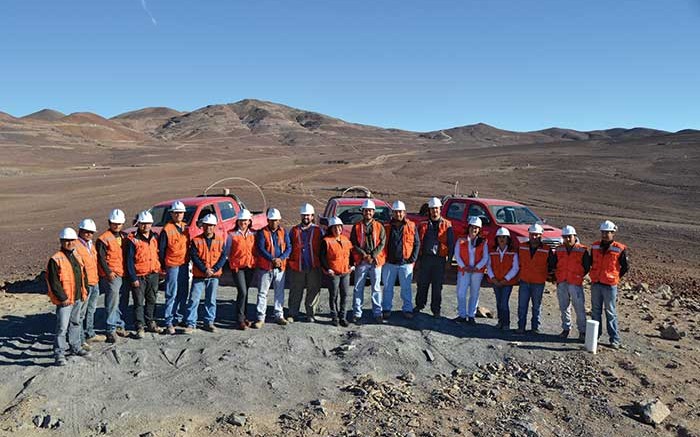With iron ore prices down by 31% in the last year, Capstone Mining (TSX: CS) is contemplating a different development plan for its 70%-owned Santo Domingo copper-iron project in Chile.
Along with the announcement July 8 that the company has received approval of the project’s environmental impact assessment (EIA) after more than three years of work with local authorities and communities, Capstone’s president and CEO Darren Pylot said the company would undertake a feasibility study on a phased approach on the project’s copper portion at half the initially planned throughput rate, followed by iron “if and when it makes sense.”
On a conference call, Pylot said that “we are fortunate with the Santo Domingo deposit to have two products — both copper and iron — so the advancement of the project does not solely depend on current or projected iron prices.”
“We will run the study on a reduced throughput of somewhere between 30,000 and 35,000 tonnes per day,” he said. “We wouldn’t initially need any of the magnetite processing facilities, magnetite concentrate pipeline or port for the iron, all of which was included in the feasibility study.”
The updated feasibility study will pick up from an internal analysis of a phased approach the company has undertaken, and should be completed in the first quarter of next year, he said.
Under the July 2014 feasibility study, the company examined the ddevelopment of two open-pit mines using conventional drilling, blasting, loading with diesel hydraulic shovels, and truck haulage; and a copper-iron concentrator designed to process a nominal 60,000 to 65,000 tonnes per day, using semi-autogenous grinding and ball milling, and conventional flotation with seawater, to produce a copper concentrate that would be stockpiled at the port.
Magnetite iron was to be recovered from the rougher copper tailings using low-intensity magnetic separation. The magnetite concentrate would be thickened on-site and pumped via a concentrate pipeline to the port, where it would be washed, dewatered and stockpiled. The copper and magnetite concentrates would then be loaded onto ships for transportation to third-party smelters.
Analysts reacted differently to news of the revised feasibility study.
“Although one can point to capex savings by removing [US$310 million of] iron-related components, it is not clear what the reduction in scale of the overall plant will do to mill size, grinding configuration, copper flotation capacity, structural steel and concentrate requirements, etc.,” Tom Meyer of CIBC Capital Markets wrote in a client research note. “Furthermore, optimizing the mine plan for copper-only versus copper-and-iron previously adds to the complexity of the analysis. It will take approximately nine months to figure these things out.
“Directionally, Capstone is trying to make the project net present value-positive on copper only,” Meyer said. “We believe the market will begin assigning greater value to the project and the optionality on future magnetite production.”
At BMO Research, analyst Aleksandra Bukacheva notes that “while it is encouraging that Capstone is looking for opportunities to scale down construction at Santo Domingo, it is not immediately obvious to us that a phased approach would yield superior returns.
“Santo Domingo development capex was last estimated at US$1.7 billion, which would require substantial amounts of external funding, as Capstone is forecast to generate US$100 million to 130 million per year of free cash flow in the next two years from its current operations.”
While the EIA is a milestone in de-risking the project, Bukacheva said, “multiple questions and concerns remain around the feasibility of funding and mine construction at Santo Domingo, given the current commodity price and market environment, as it relates to investor appetite for growth investment.”
Haywood Securities’ Stefan Ioannou said he conservatively pegs initial capital costs for a smaller mine plan at US$1.2 billion, and noted that as a lower-grade deposit, Santo Domingo requires economies of scale.
“The project’s [roughly] 60,000-tonne-per-day feasibility study mine plan generates 14% after-tax internal rate of return at current [US$2.50 per lb.] spot copper pricing,” he said in a client note. “We anticipate the project’s updated [smaller] mine plan economics will also be sensitive to copper pricing.”
Ioannou said that depending on market conditions, “Capstone may look to defer Santo Domingo development to pursue other opportunistic [corporate] growth initiatives.”
Capstone added Santo Domingo to its development pipeline by acquiring Far West Mining in 2011. The project is 130 km north of Copiapo in Region III, 100 km from the Pacific coast and 50 km west of Codelco’s El Salvador copper mine.
Capstone has a strategic partnership with Korea Resources Corp., a state-owned resource acquisition company, which owns the remaining 30% of the project.
The mid-tier copper producer has three producing mines: Pinto Valley (copper) in Arizona, Cozamin (copper-silver) in Zacatecas state, Mexico, and Minto (copper) in Canada’s Yukon territory. It also owns 100% of the copper-zinc Kutcho project in B.C.
At press time Capstone’s shares traded at $1.16 apiece, within a 52-week range of $1.04 to $3.11.
CIBC’s Meyer has a 12- to 18-month target price on the company of $3 per share. BMO’s Bukacheva has a $2.50 per share target price.


Be the first to comment on "Capstone gets positive EIA, mulls new plan at Santo Domingo"